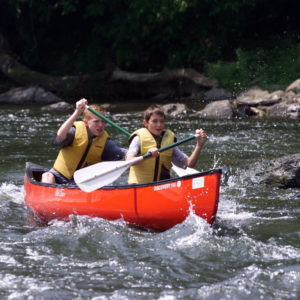First and foremost, as you launch the canoe make sure the open side is up. (Just how basic do we need to be here?) Seriously though, when launching your canoe make sure to put it all the way in the water. Otherwise, when you get in and part of the canoe is still on land, you’re not going anywhere. If it’s shallow, it may be best to walk the canoe into the water a little before stepping in. Place your paddles, cooler, or any other duffle into the canoe before stepping in. Make sure to steady yourself by gripping the both gunwales with both hands and stay low as you step in to middle of the boat (between the two sides) to keep the canoe from squirting out from under you.

Canoes are configured to paddle in one direction. You can tell by the placement of the seats. The seats are alway noticeably set back toward the stern, or rear of the canoe. The seat with the most space between it and the end of the canoe is the bow, or front seat (more leg room). Any third person should sit on the floor of the canoe (preferably on a cushion) between the two seats.
Paddling a canoe properly requires teamwork. The stern paddler is responsible for steering the canoe, so it makes sense this should be the more experienced or athletic paddler. The bow paddler has a better vantage point to observe obstacles or the best route through a ledge or rock garden for example. Communication via voice or hand gestures is helpful, but after you have paddled together a few times, the stern paddler will learn to “read” the paddle movement and body language of the bow paddler without effort.
STERN PADDLER: You may simply use your paddle as a rudder to steer the canoe. If you are right handed, and paddling on the right side, the canoe will naturally want to veer a little to the left on every stroke regardless of what the bow paddler is doing. To correct for this, you may elect to do a steering maneuver every third or fourth stroke or so. You may also switch sides frequently as well. A better method of course correction is to use a “J” stroke by rotating the blade outward away from the canoe (in the shape of a J) at the end of the stroke. This is much more efficient and less tiring.
The two paddlers in a canoe should paddle on opposite sides of the canoe most of the time. Since most people are right handed, most of us will be paddling on our “off side” about half the time, so get used to it. Paddlers should switch sides at regular intervals. The bow paddler determines when to switch since that person is always in the line of sight of the stern paddler who then adjusts to the bow paddler’s lead.
BOW PADDLER: HE wanted to paddle stern and be the captain. HE wanted to be the boss. Play the Cleopatra role by being conveyed down the river. Make an occasional gesture by simulating a paddle stroke, but don’t put any effort into it. Have a glorious day.
Modern river canoes are flat bottomed and are made of rotomolded plastic which slips over rocks much more easily than aluminum or fiberglass. Most are 16’ to 17’ in length, have no keel, are quite maneuverable and extremely durable if a bit heavy (80 pounds or so). These canoes can usually make about 3 miles an hour down the river at a steady but not strenuous pace, so a 12 mile trip should take about 4 hours paddle time at normal river levels.
Have a clear understanding of your route and distance. Carry a cell phone (but silence it and use it only for photos unless a need arises understanding cell coverage may be limited). Know how to recognize your take out. Finally, and very importantly, get wet, chill out, and have a great day on your canoe adventure.
